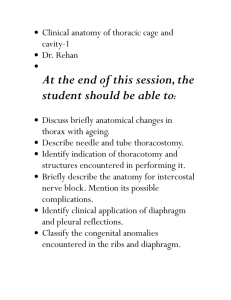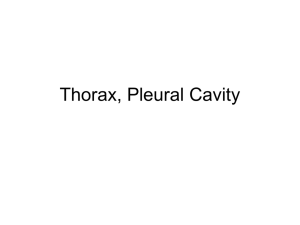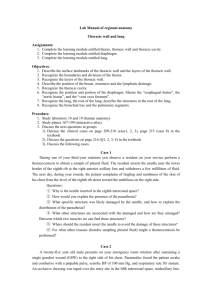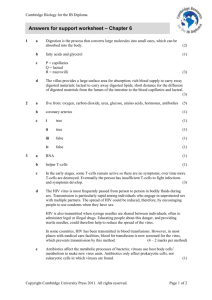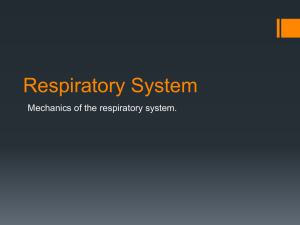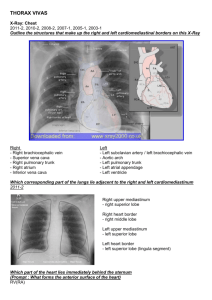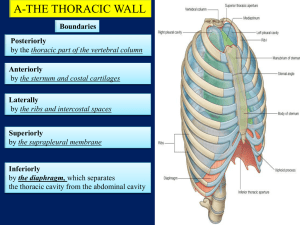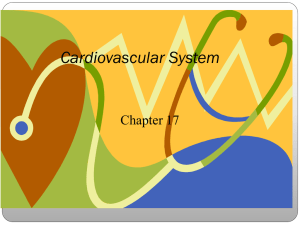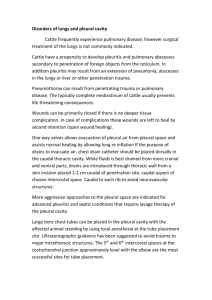thoracic wall, intercostal spaces and intercostal muscles
advertisement
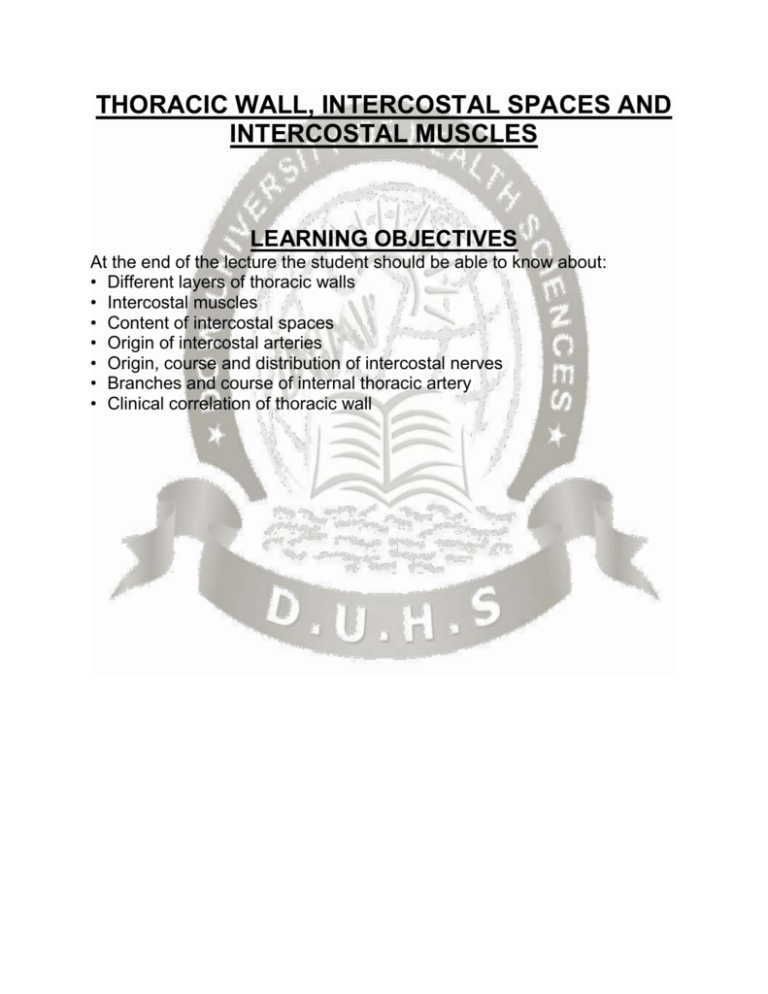
THORACIC WALL, INTERCOSTAL SPACES AND INTERCOSTAL MUSCLES LEARNING OBJECTIVES At the end of the lecture the student should be able to know about: • Different layers of thoracic walls • Intercostal muscles • Content of intercostal spaces • Origin of intercostal arteries • Origin, course and distribution of intercostal nerves • Branches and course of internal thoracic artery • Clinical correlation of thoracic wall INTRODUCTION TO THORACIC WALL • • • • • • • Osseo cartilaginous framework Anteriorly formed by sternum and costal cartilages Laterally by ribs and intercostal spaces Posteriorly by thoracic vertebrae Covered by skin and fascia Muscles attach it to shoulder girdle Lined by pleura THORACIC WALL • Covered by the following structures from outside to inside • Skin • Superficial fascia – Thoracoepigastric v. – Supraclavicular n. – Anterior and lateral cutaneous branches of intercostal n. – Mammary gland • Muscles • Deep fascia– endothoracic fascia • Parietal pleura CUTANEOUS INNERVATION OF CHEST WALL Anteriorly • Above sternal angle; T4; from Supraclavicular nerves • Below sternal angle, anterior and lateral cutaneous branches of intercostal nerve Posteriorly • Dorsal rami of spinal nerves THE MUSCLES OF THORAX Extrinsic muscles • Pectoralis major • Pectoralis minor • Serratus anterior Intrinsic muscles • • • • Intercostales externi Intercostales interni Intercostales intimi Transverses thoracis INTERCOSTAL SPACES • Spaces between ribs • 11 in number • Contain three layers of muscles of respiration – External intercostal – Internal intercostal – Innermost inter costal • Last one lined by endothoracic fascia and then parietal pleura • Each intercostal space has its own neurovascular bundle EXTERNAL INTERCOSTAL MUSCLES • Most superficial of intercostals muscle Origin • Inferior border of the rib above • Insertion • Superior border of the rib below Course • Fibers run downward and forward • Extends from the costal tubercle to the costochondral junction where it is replaced by anterior intercostal membrane • Action: elevate ribs adding in forced inspiration INTERNAL INTERCOSTAL MUSCLES • Forms intermediate layer Origin • Subcostal groove of the rib above Insertion • Upper border of rib below Course • Fibers runs downward and backward from sternum to angle of the rib • At angle of the rib it forms posterior intercostal membrane • Action: depress ribs for forced expiration INNERMOST INTERCOSTAL • • • • • • Deepest layer Crosses more than one intercostal space Related internally to endothoracic fascia and parietal pleura Externally related to intercostal vessels and nerves Variable muscle Uncertain function NEUROVASCULAR BUNDLE OF INTERCOSTAL MUSCLES • Inter costal vessels and nerves • Run between internal and innermost intercostal layer • Arranged in following order from above downwards – Intercostal vein – Intercostal artery – Intercostal nerve • Runs in subcostal groove • Runs near the upper margin of concerned intercostal space INTERCOSTAL ARTERIES • Two anterior intercostal and one single posterior intercostal artery in each space Anterior intercostal arteries • Of first six spaces from internal thoracic artery • Of last six are the branches of musculophrenic artery POSTERIOR INTERCOSTAL ARTERIES • Subclavian artery costocervical trunk superior intercostal arteryposterior intercostal arteries of first 2 spaces • Those of last 9 spaces from descending thoracic aorta INTERCOSTAL VEINS Posterior intercostal veins • Drain into azygos or hemiazygos veins Anterior intercostal veins • Drain into internal thoracic and musculophrenic vein INTERCOSTAL NERVES • Anterior primary rami of first 11 thoracic spinal nerves • Enter intercostal space between parietal pleura and posterior intercostal membrane • Runs at the lower border of rib between internal intercostal and inner most intercostal • 1st to 6th remain in their space • 7th to 9th pass deep to costal cartilage enter abdominal wall • 10th and 11th enter directly abdominal wall Branches –Collateral branchruns in the same space at upper border of rib below –Lateral cutaneous branch –Anterior cutaneous branch –Muscular branches –Pleural sensory branches –Peritoneal sensory branches DISTRIBUTION 1st to 6th supply: • Skin and parietal pleura of intercostal spaces • Intercostal muscles of these spaces 7th to 11th supply: • Skin and parietal peritoneum of outer inner surface of abdominal wall • Anterior abdominal wall muscles INTERNAL THORACIC ARTERY • • Branch of 1st part of subclavian artery in neck • Descends vertically on the pleura behind costal cartilage • Ends in 6th intercostal space by dividing into superior epigastric and musculophrenic artery Branches: – 2 Anterior intercostal arteries for each of the upper six spaces –Perforating arteries –Pericardiophrenic artery –Mediastinal arteries –Superior epigastric artery –Musculophrenic artery INTERNAL THORACIC VEIN • Accompanies internal thoracic artery • Drains into brachiocephalic vein on each side CLINICAL CORRELATES • • Disease in thorax • Pain feel along costal margin to anterior abdominal wall • 7th to 11th intercostal nerve supplies anterior abdominal wall Herpes zoster • Latent varicella zoster infection • Inflammation and degeneration of sensory neuron • Formation of vesicle • In thorax, band of pain in intercostal dermatome followed by vesicle NEEDLE THORACOSTOMY •Insertion of needle in the pleural cavity –Drainage of air, pus, blood –Drawing a sample •Anterior or lateral approach •Needle passes through –Skin, superficial fascia –Serratus anterior –External intercostal muscles –Internal intercostal muscles –Inner most inter costal –Endothoracic fascia –Parietal pleura •Needle should be kept close to upper border of rib below to avoid injury to VAN INTERCOSTAL NERVE BLOCK • In repair of laceration, fracture • Intercostal nerve should be blocked before cutaneous arise • Needle should be directed towards the rib border, in subcostal groove • COMPLICATION • Pneumothorax • Hemorrhage the lateral near lower
